Anyone used Starlink with camera traps before?
11 September 2024 4:58am
15 October 2024 7:15pm
Really nice to see you put so much effort in for the birds Graeme. Top!
29 March 2025 2:24pm
Using some cheap WiFi router (brand Comfast) which has a USB port where I connected a USB SSD drive 1GB. I have flashed it with OpenWRT, rebuilt ffmpeg (as ffmpeg-custom) to support proprietary codecs of my cameras and using some shell scripts of mine for the recording. The cameras are:
- Hamrol rtsp://$IP_ADDRESS:554/user=${LOGIN}_password=${PASSWORD}_channel
- Tesla Czech rtsp://admin:admin@$IP_ADDRESS:8554/Streaming/Channels/101
That is the part recording 8 cameras to the SSD drive (1GB fits 10 days). And then I have some code of mine to be streaming it from the SSD drive over Starlink to my VPS server.
It would work fine but the Starlink streaming part I had to stop as my Starlink router gets very very hot (I cannot hold my hand on it) and around noons Starlink is restarting multiple times. It is Starlink 2nd generation. Unaware whether due to the router being hot or due to the antenna being hot - I see no "hot" message in the Starlink Android app which some people say one could see. It is very hot here during summer in Philippines but the antenna is high on a tree so I cannot touch it (but it must be very hot even just from the sun).
I am investigating how to cool down at least the router. Then maybe I could be streaming at least during nights when a burglary is more probable and they could steal even the SSD drive. Or maybe Starlink 3rd gen. is no longer so overheating? Dunno.
Multiple grants
28 March 2025 1:42pm
PhD position on bat acoustics and collective behavior
28 March 2025 1:05pm
non-invasive technique to apply GPS collars without catching?
14 June 2021 12:01pm
13 April 2024 11:48am
Might very well be so! I highly encourage you to take up the challenge!
26 November 2024 11:34pm
In case anyone missed it, the latest from the burr on fur work!
Telemetry without collars: performance of fur- and ear-mounted satellite tags for evaluating the movement and behaviour of polar bears | Animal Biotelemetry | Full Text
The study of animal movement provides insights into underlying ecological processes and informs analyses of behaviour and resource use, which have implications for species management and conservation. The tools used to study animal movement have evolved over the past decades, allowing for data collection from a variety of species, including those living in remote environments. Satellite-linked radio and GPS collars have been used to study polar bear (Ursus maritimus) ecology and movements throughout the circumpolar Arctic for over 50 years. However, due to morphology and growth constraints, only adult female polar bears can be reliably collared. Collars have proven to be safe, but there has been opposition to their use, resulting in a deficiency in data across much of the species’ range. To bolster knowledge of movement characteristics and behaviours for polar bears other than adult females, while also providing an alternative to collars, we tested the use of fur- and ear-mounted telemetry tags that can be affixed to polar bears of any sex and age. We tested three fur tag designs (SeaTrkr, tribrush and pentagon tags), which we affixed to 15 adult and 1 subadult male polar bears along the coast of Hudson Bay during August–September 2021–2022. Fur tags were compared with ear tags deployed on 42 subadult and adult male polar bears captured on the coast or the sea ice between 2016 and 2022. We used data from the tags to quantify the amount of time subadult and adult males spent resting versus traveling while on land. Our results show the three fur tag designs remained functional for shorter mean durations (SeaTrkr = 58 days; tribrush = 47 days; pentagon = 22 days) than ear tags (121 days), but positional error estimates were comparable among the Argos-equipped tags. The GPS/Iridium-equipped SeaTrkr fur tags provided higher resolution and more frequent location data. Combined, the tags provided sufficient data to model different behavioural states. Furthermore, as hypothesized, subadult and adult male polar bears spent the majority of their time resting while on land, increasing time spent traveling as temperatures cooled. Fur tags show promise as a short-term means of collecting movement data from free-ranging polar bears.
28 March 2025 10:15am
Reopenning this discussion again in case there is some news!
Turn old smartphone into IA camera trap?
24 September 2021 1:08pm
3 December 2024 12:08pm
Hi @rcz133 do you have any news regarding your project? thanks for sharing :)
13 December 2024 8:00pm
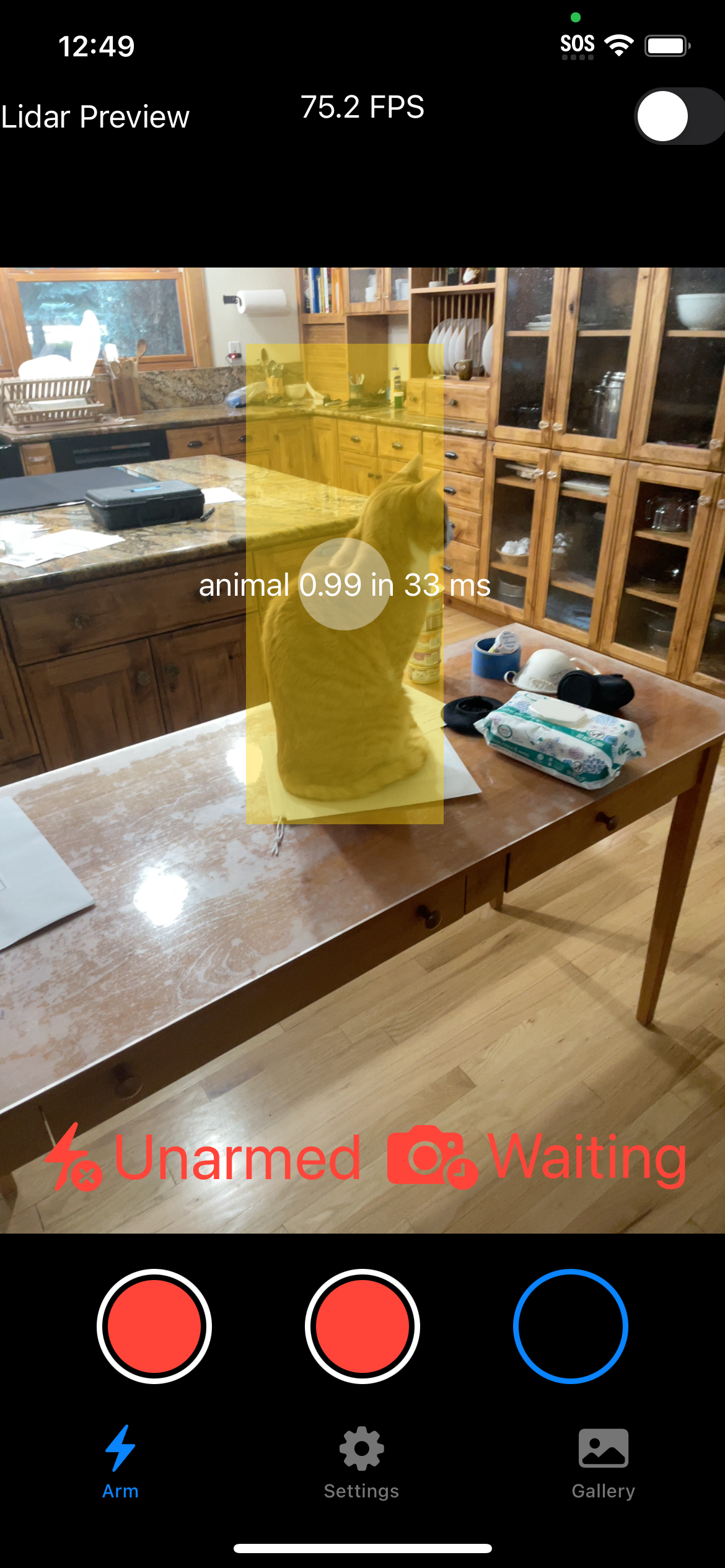 Yes!
Yes!
I actually have a prototype up. Short summary is that it does most of the things I wanted it to do, but consumes too much power in the process.
Longer story: The prototype demonstrates the following tech:
- Looping video which allows “negative trigger delay”
- Daytime trigger via camera sensor
- Nighttime trigger via built-in LIDAR sensor
- Trigger based on MegaDetector 6c
- Saves video into iPhone video library
Unfortunately, as it stands (and as was noted earlier in this thread), it consumes too much power while doing all this. The problem, BTW, is not the AI stuff, or even the active LIDAR sensor – it’s keeping the basic video processing pipeline -- which is necessary for the "negative trigger delay", and the AI-based trigger mechanism.
This is definitely in the “proof of concept” and debug phase, and lacks such “niceties” as robustness, UI design, etc. It’s very far away from the Apple store .
I’ve taken a break from the project to contemplate options for power reduction. I’ve been meaning to cleanup and make public the GitHub site with the prototype code, as well as some documentation. If there’s interest in this group, especially by anyone with time/interest to look more closely at the power problem, let me know, and I’ll move it up my priority list
28 March 2025 9:29am
Hi @rcz133 thanks for the update it looks promissing! An external motion PIR as @EDsteve develloped could help reduce the power consumption related to the video pipeline, but so it required additional part, that the smartphone itself.
As you share it maybe someone will have a solution and we stay in touch for potential update.
Thanks,
Best,
Using drone or other unmanned vehicle for DNA sampling on fresh elephant dung in a Baï, Congo Rainforest.
29 January 2024 9:44am
30 January 2024 9:01pm
Forgot to mention this wildlife drone group -
18 March 2025 4:00pm
Hi Antoine,
Maybe I am a bit late but stumbled across your post. We have built a system to collect DNA samples from the rainforest with a drone hovering above the canopy, and we lower a probe more than 40 meters down into the canopy. Something similar could be done for your case, and as the drone hovers above, the noise is somewhat reduced. Feel free to reach out if you want to further discuss this!
28 March 2025 9:14am
Hi @skirchgeorg , thanks for the additional info. We discuss again about this with my colleague and we were still hesitating with the drone, as it will still make some noise that will deter elephant away unless we can cover it with a natural sound. And it term of control drone are not the easiest, and some bird will also attack it (already have experience that in similar context). So after discussion we were more thinking about a rover camouflaged in elephant dung or something else, that will be able to bring back a piece of elephant dung for DNA analysis. This rover will only be able to access the dry part of the baï, but it would be easier to control and we could also attach a small rope in case of problems to bring it back to the platform. If you have any ideas to develop this rover, please contact me!
5 Insights from the 2024 Network Survey
27 March 2025 8:21pm
2 April 2025 10:21am
14 April 2025 6:32pm
17 April 2025 4:36pm
Graphic interface for wildlife species ID of camera trap data?
27 March 2025 4:02pm
27 March 2025 7:45pm
Training remains somewhat more of a hassle than inference, but thanks to a WILDLABS grant, our friendly neighborhood machine learning folks at DrivenData are working to narrow that gap:
https://wildlabs.net/discussion/wildlabs-awards-2024-no-code-custom-ai-camera-trap-species-classification
I know that's just a post about a thing they are going to build, but I wouldn't have posted that link if I weren't 100.0000% confident that it was not vaporware, so, stay tuned.
Also, I know I'm super-biased, so take this with a grain of salt, but in my experience the recent release of our SpeciesNet model changes the equation significantly re: when it's worth training your own model. SpeciesNet saw tons of PNW data in training, and I've run it on a gazillion images from the PNW since its release, and it works quite well. If it doesn't work as well as you'd like out of the box, consider doing some postprocessing as an alternative to training your own model. It can be tempting to compare a model that doesn't exist yet to one that does, and assume that the former will be perfect, but no model is perfect, and even if the custom model would be a little better, the time it takes to train and maintain a custom model may be more than the time you would save thanks to the delta in accuracy.
OK, taking off my super-biased hat now, YMMV.
SCGIS International Conference: Geospatial Technology Innovations for Conservation
27 March 2025 6:35pm
Time-lapse cameras for monitoring nesting birds in the Arctic
11 January 2023 6:37am
20 January 2023 1:03am
Thanks Alasdair!
The Plotwatchers and Brinnos didn't require any solar for the 500K on 4aa batteries. We place the cams near the nest (actually at the nest peering into the nest bowl with a new design I came up with where the only thing above ground is a ribbon cable and the camera board attached to a metal rod we lag blot to the tundra, the batteries and main board are in a 1020 pelican case and buried; see below for an image of the above-ground portion of the cam and an image of a nest from a cam [if you look closely you can see one of the eggs just hatched and there are now 3 eggs and 1 chick in the bowl]).
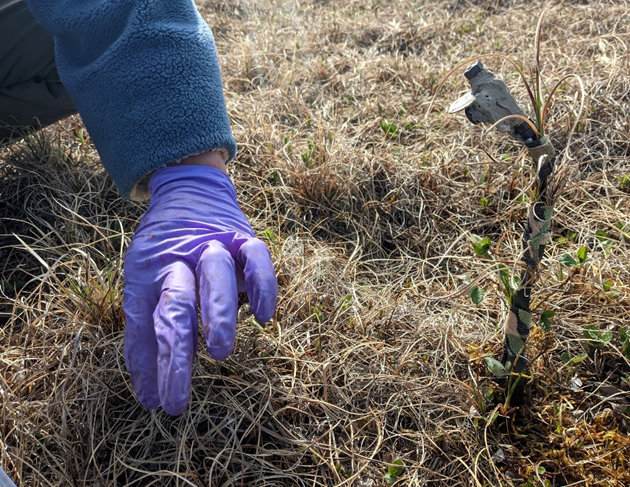
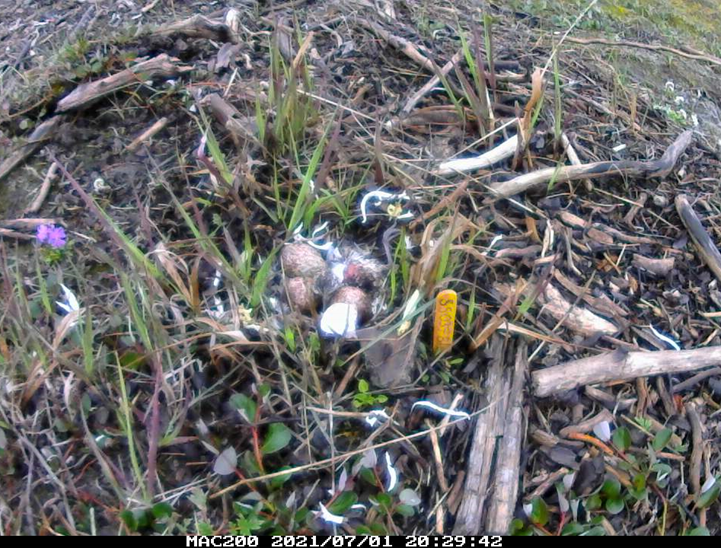
I'd be very interested in what you all are working on for the next design. How small would it be?
27 January 2023 11:28am
Thanks Chris,
Probably quite similar in size to your existing setup above, but we'd use two Li-ion rechargable batteries most likely (could be an 18500). I'll be sure to share more information later this year.
Cheers,
Alasdair
27 March 2025 4:03pm
Hi all,
I'm interested in this post for another context, tropical rainforest. I want to monitor forest cleareance in the Congo bassin rainforest through time-lapse images. Unfortunately, the Bushnell camera I used got stolen, and so I'm looking for a tiny time-lapse camera that will be more difficult to detect.
@chris_latty The picture you shared in comment looks promising. How did you do it? from a Brinno camera? Thanks.
Technical Report: Using the FLIR ONE Thermal Camera to detect wild animals
27 March 2025 11:57am
🌊 FathomVerse mobile game debuts new features to help gamers participate in ocean exploration
27 March 2025 1:20am
27 March 2025 1:27am
Play FathomVerse: App Store | Google Play
Join the Community: Discord | Instagram | TikTok | LinkedIn
Stay up-to-date: Subscribe to our Newsletter
Contact us: fathomverse@mbari.org
Learn more: www.fathomverse.game
WILDLABS AWARDS 2024 - BumbleBuzz: automatic recognition of bumblebee species and behaviour from their buzzing sounds
12 April 2024 8:37am
12 April 2024 8:41pm
Super great to see that there will be more work on insect ecoacoustics! So prevalent in practically every soundscape, but so often over-looked. Can't wait to follow this project as it develops!
17 April 2024 10:23am
Thanks Carly! I will keep anyone interested in this project posted on this platform. Cheers
26 March 2025 8:08pm
Really looking forward to following this project. I'm very curious how you'll be able to tease out different species, particularly among species that feature a variety of worker sizes.
Ai agents for conservation
26 March 2025 8:08pm
Nature Tech Unconference - Anyone attending?
8 March 2025 12:11pm
15 March 2025 8:28am
Definitely!
21 March 2025 12:07pm
The Futures Wild team will be there :)
26 March 2025 7:54pm
Yep see you on friday
Generative AI for simulating landscapes before and after restoration activities
26 March 2025 1:59pm
26 March 2025 7:50pm
Yep we are working on it
#berlin #ia #paysage #naturetech #solutionsfondéessurlanature #greentech… | Olivier Rovellotti 🌍 | 11 comments
🌿 Quand la Technologie Devient L'alliée du Paysagiste 🌍 🎨 Imaginer & Générer Grâce à l’IA générative (Stable Diffusion, Segment Anything), on peut imaginer #Berlin plus verte et tester différents scénarios d’aménagement. Une nouvelle manière d'explorer les possibles, en s’inspirant des principes des plus grands (McHarg, Clément, Burle Marx). 🌳💡 https://lnkd.in/g-uM7d-k 📚 Apprendre Les plateformes comme NBS EduWORLD rendent les solutions fondées sur la nature plus accessibles à tous. https://lnkd.in/gnBTkyN5 🔎 Cartographier & Anticiper Des outils comme ecoTeka permettent d’identifier les espaces à renaturer en croisant données SIG et IA. Cartographie, suivi des arbres, calcul des services écosystémiques… https://lnkd.in/daTBxbwn 🔗 Réfléchir: Dans "Harnessing generative AI to support nature-based solutions", Sandra Lavorel et Al nous donne des pistes d'explorations pour aller plus loin https://lnkd.in/gSH6Au9s 💬 Et vous ? 🌱🤖 #IA #Paysage #NatureTech #SolutionsFondéesSurLaNature #GreenTech #Biodiversité #NBSEduWorld #FosterTheFuture #TeachFromNature #NatureBasedSolutions #ClimateChange #STEM | 11 comments on LinkedIn
1/ segment
2/remote unwanted ecosytem
3/get local potential habitat
4/generate
5/add to picture
Cloud-Native Geospatial Conference
26 March 2025 3:40pm
WILDLABS Awards 2025: Meet the judges
 WILDLABS Team
and 1 more
WILDLABS Team
and 1 more
26 March 2025 1:13pm
14 April 2025 11:43am
14 April 2025 7:23pm
16 April 2025 6:09pm
2025 AI upskilling workshop for former US/state environmental scientists
 Sara Beery
and 2 more
Sara Beery
and 2 more
25 March 2025 7:10pm
AI Weather Quest
25 March 2025 5:07pm
United Nations Open Source Principles
13 March 2025 4:13pm
25 March 2025 11:54am
All sound, would be nice if there were only 5, though!
Thank you and farewell!
7 February 2025 6:27pm
22 February 2025 1:34pm
All the best, and I'd like to think Bill the dog will be enjoying more walkies.
21 March 2025 8:27pm
You'll be missed sorely, Steph! Thank you for putting your heart & soul into building this community! Wildlabs.Net won't be what it is today, without your hard work! Hope you'll continue to stay in touch. Have a relaxing Sabbatical and best wishes for your next adventure! ❤️
25 March 2025 9:30am
Good afternoon Stephanie!
It is sad to see you go, but very exciting to hear that you will be on adventures new very soon! I wish you all the best in your future endeavours and thank you for this brilliant project that is Wildlabs, it is a truly wonderful community.
Take care, all the best and kind regards
Sean Hill
Mole-Rat Mystery. Can anyone help?
19 March 2025 3:25pm
20 March 2025 4:17pm
Hi Sean! I love that you are naturally curious and are pursuing really cool projects in your free time. I know absolutely nothing about cape dune mole rats (in fact, never heard of them prior to this post, but I will confess I was interested in the concept of a mole-rat mystery), but I did have some thoughts about where you might find more information-
It seems like the types of questions you are asking are pretty specific and niche. My first thought on how to find someone with expertise in these specific rodents was to go to their iNat page- there you can see the top observer and top identifier. Both individuals are active researchers, so I think reaching out to them on iNat or finding their e-mails from their respective organizations' sites might be a good way to get in touch.
I also did a quick search in Google Scholar in which I typed in only the scientific name and hit go. The two publications linked above caught my eye as potentially helpful in your search- particularly the first one. They excavated burrows and noted things like home range size, that males have more burrows than females, etc. I didn't go much beyond the abstracts but these seem like they might get you on the right tracks!
Happy ratting!
25 March 2025 8:36am
Good morning Vance
Thank you very much! I am looking into some papers that I was kindly directed to by Jocelyn Stalker ( her comment below) and am looking for ways to establish population dynamics just by looking at the mounds. Once I have figured this part out I should be able to correlate the information to the drone data. The Ground Sampling Distance (GSD) for this project is very small, 1.3cm per pixel. This has proven to be very useful because I am able to use the very fine 3D models to run change detections that pick up new heaps and vegetation reductions (which may be due to feeding) on a weekly basis. It helps not only visualise but also quantify where the most activity has occurred. I will keep you posted!
25 March 2025 8:47am
Good morning Jocelyn
Thank you very much for your comment, this is proving to be very useful advice and thank you so much for setting me on the right path!! This is very exciting!!
They are the most extra ordinary little creatures and as I don't know much about them either, I thought I'd try learn as much as I can (not just through literature, but through my own observations as well). I walk past these mounds daily and am always intrigued when I see more mounds and really enjoy watching them actively push the dune sand up to the surface (you don't see the wee fellas but you can watch the sand move as they burrow away). One afternoon while flying my drone (I was quantifying the changes in sediment deposition and erosion volumes in the estuary after a flood that was soon followed by a super high tide), I had a heap between my legs and all of a sardine it starts moving! So that sparked my curiosity even further.
I will keep you posted on my findings and thank you again for the papers and the direction! It is greatly appreciated!!
InsectSet459: an open dataset of insect sounds for bioacoustic machine learning
24 March 2025 5:46pm
Postdoctoral fellow in AI for Ultrasonic Bioacoustic Monitoring
24 March 2025 3:31pm
Transitioning to GIS from Tech
17 March 2025 10:54am
Wildlife Detection/Identification App for Security personnel at Airports.
5 October 2024 3:49am
7 October 2024 10:37am
Within the African Wildlife Forensics Network many investigators, customs officials and the like use the IDentifyIT App for species, and now cycads. It is a continual work in progress but it helps with in situ morphological ID.
13 March 2025 5:41pm
Not for ID but there is a "Wildlife Sentinel" app too. Great Idea by the way.
23 March 2025 12:55pm
Hi,
Thank you for your message I think there's some kind of application for this app not by itself by complementing technologies like NABIT, mentioned in an earlier comment.
So, haven't found anyone so far to have a full fledged discussion and feasibility of this idea yet.
Seeking to contribute to this space
22 March 2025 10:17am
23 March 2025 1:06am
Hi Tanakrit,
Thanks for your post and welcome!
I am almost in the same boat as you, with some differences.
You might lookup my old post here
https://wildlabs.net/discussion/switch-conservation-it
As I am trying to figure it out, there is no set framework or template to follow. You can try the following which I plan to try as well:
Finish the Wildlabs courses.
Try the inventory section and check if any company/ org has any overlapping skillset as yours. Contact them with your interest.
Network in any group of interest.
Reach out for volunteering/ citizen science program where you see any.
Associate with other conservation tech people in your area.
There may be more. But these are some I could quickly think about.
Compute for Climate Fellowship 2025: Empowering Climate Tech Startups with Cloud Computing and AI
22 March 2025 4:13pm

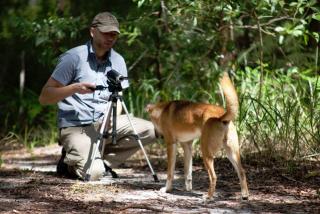







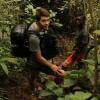
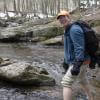






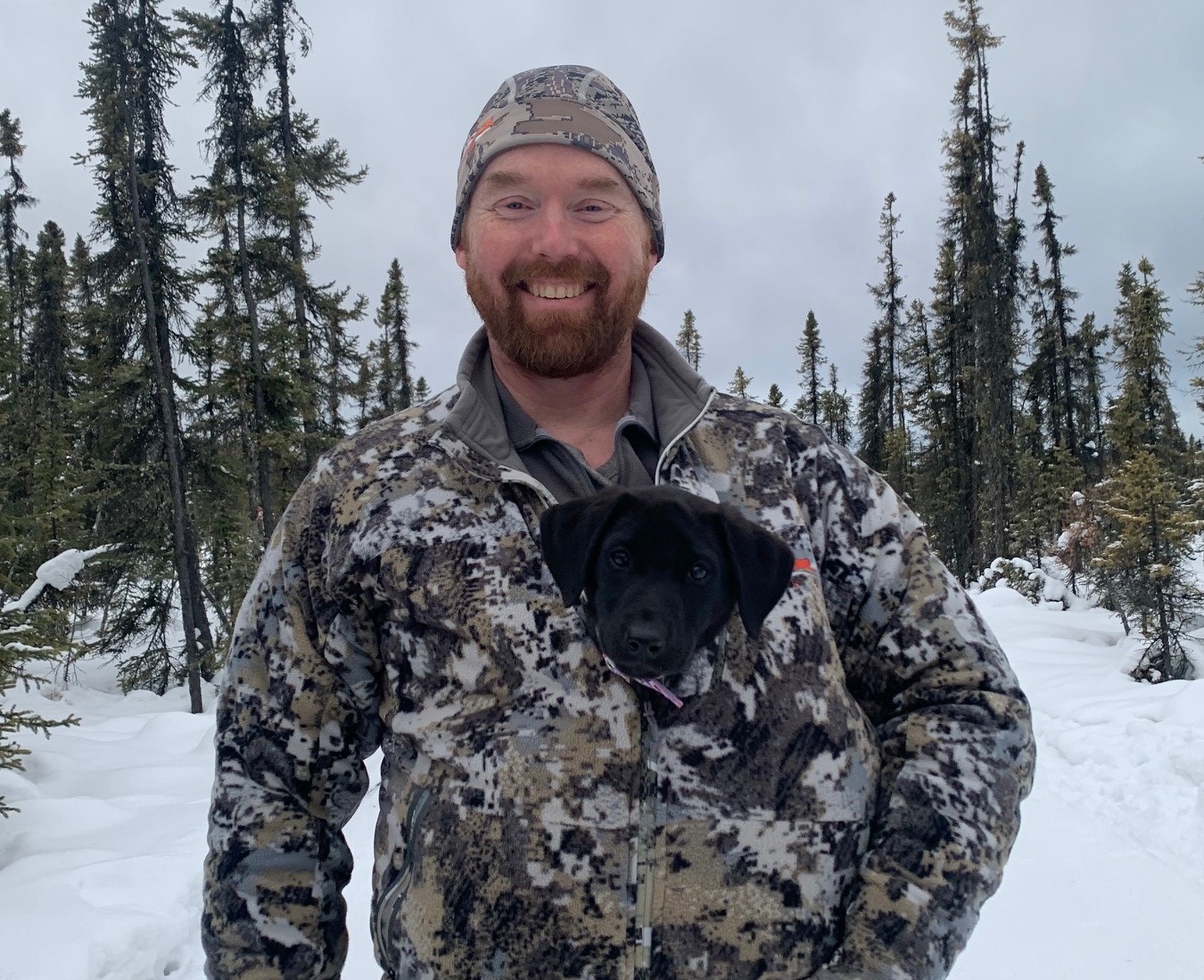
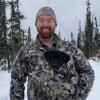

















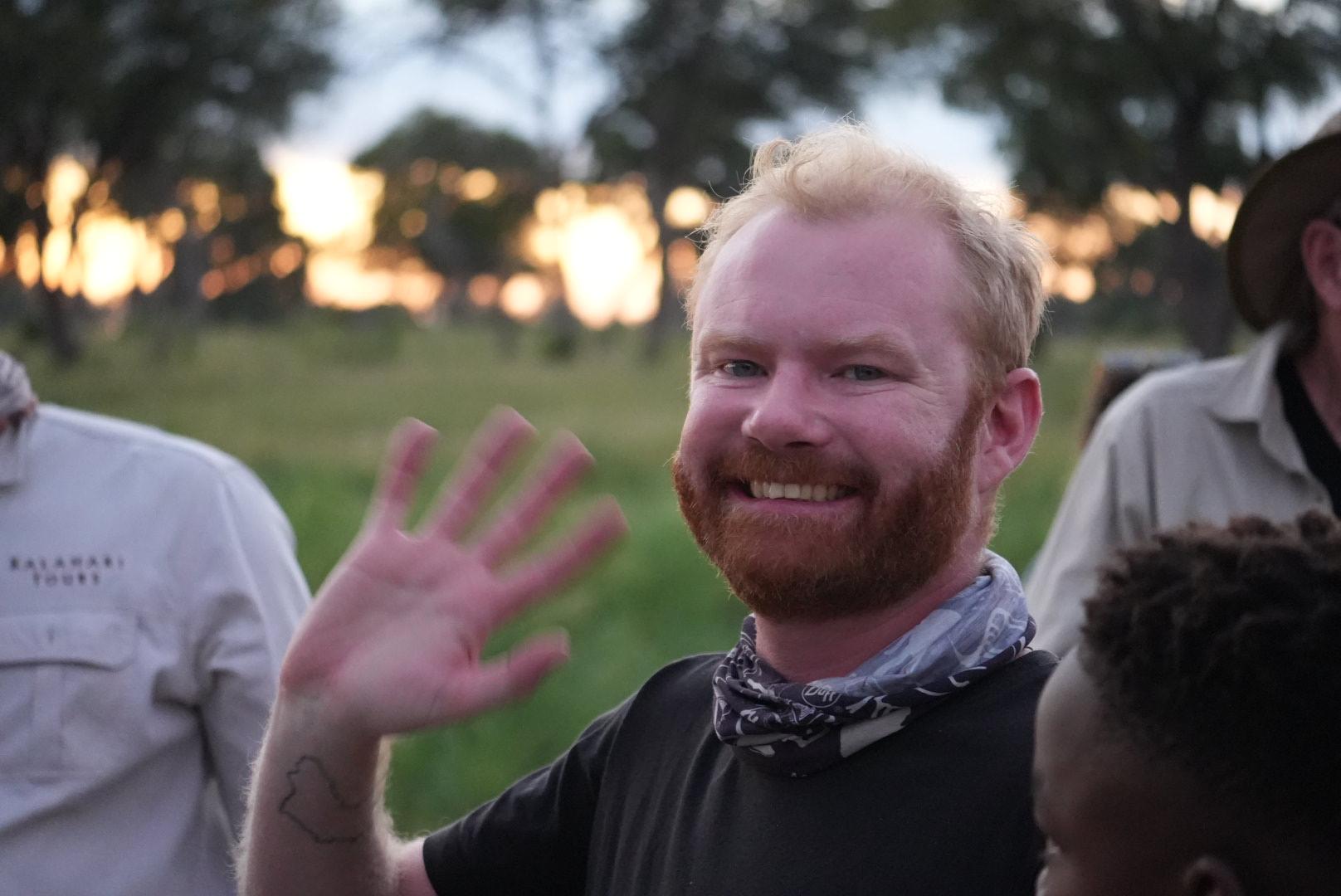



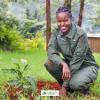



15 October 2024 2:41pm
Hopefully the extra batteries Graeme has ordered will help with a bit of redundancy for rainy/cloudy days and at night. As you and @tve suggested @kimhendrikse, something akin to a 'threshold' minimum amount of storage might be a good way to manage the system/uploads - since Graeme has that solar controller app., he can actually see when there's enough charge/not enough (I think?), so perhaps there's an alert for a low level of battery charge @GraemeTonkin?
Cheers,
Rob